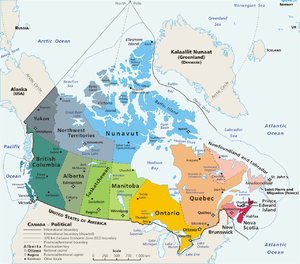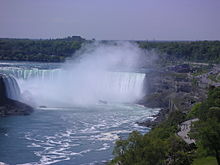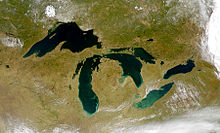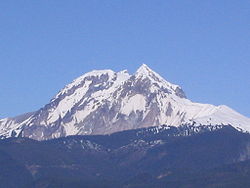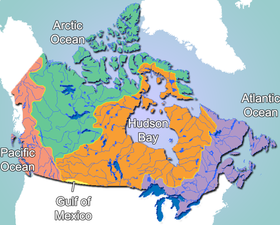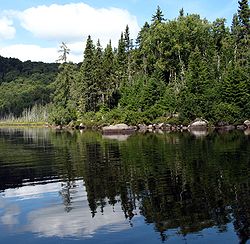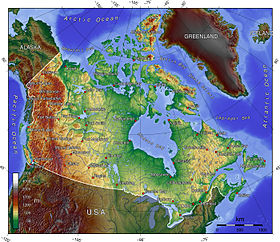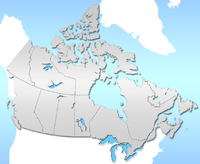- Geography of Canada
-
Canada Continent North America Subregion Northern America Geographic coordinates 60°00′N 95°00′W / 60°N 95°W Area
- Total
- WaterRanked 2nd
9,984,670 km2 (3,855,103 sq mi)
891,163 km2 (344,080 sq mi) (8.92%)Coastline 202,080 km (125,567 mi) Land boundaries 8,893 km (5,526 mi) Countries bordered US 8,893 km (5,526 mi) Maritime claims 200 nmi (370.4 km; 230.2 mi) Highest point Mount Logan,
5,959 m (19,551 ft)Lowest point Atlantic Ocean, 0 m Longest river Mackenzie River,
4,241 km (2,635 mi)Largest inland body of water Great Bear Lake
31,153 km2 (12,028 sq mi)Land Use
- Arable land
- Permanent
crops
- Permanent
pastures
- Forests and
woodlands
- Other
5%
0%
3%
54%
38% (1993 est.)Climate: temperate in south to subarctic or arctic in north Terrain: mostly plains with mountains in west and lowlands in southeast Natural resources iron ore, nickel, zinc, copper, gold, lead, molybdenum, potash, diamonds, silver, fish, timber, wildlife, coal, petroleum, natural gas, hydropower Natural hazards permafrost, cyclonic storms, tornadoes, forest fires Environmental issues air and water pollution, acid rains Portal Geography of Canada This video was taken by the crew of Expedition 29 on board the ISS. The pass goes over Canada and Central United States.
The geography of Canada is vast and diverse. Occupying most of the northern portion of North America (41% of the continent), Canada is the world's second largest country in total area.
Canada spans an immense territory between the Pacific Ocean to the west and the Atlantic Ocean to the east and the Arctic Ocean to the north (hence the country's motto "From sea to sea"), with the United States to the south (contiguous United States) and northwest (Alaska), and the Arctic Ocean to the north; Greenland is to the northeast. Off the southern coast of Newfoundland lies Saint-Pierre and Miquelon, an overseas collectivity of France. Since 1925, Canada has claimed the portion of the Arctic between 60°W and 141°W longitude to the North Pole; however, this claim is contested.[1]
Covering 9,984,670 km2 or 3,855,100 sq mi (Land: 9,093,507 km2 or 3,511,023 sq mi; Water: 891,163 km2 or 344,080 sq mi), Canada is slightly less than three-fifths as large as Russia, nearly 1.2 times larger than Australia, slightly larger than Europe, and more than 40 times larger than the UK. In total area, Canada is slightly larger than both the U.S. and China; however, Canada ranks fourth in land area (i.e., total area minus the area of lakes and rivers)—China is 9,326,410 km2/3,600,950 sq mi and the U.S. is 9,161,923 km2/3,537,438 sq mi[2]
The northernmost settlement in Canada (and in the world) is Canadian Forces Station (CFS) Alert (just north of Alert, Nunavut) on the northern tip of Ellesmere Island—latitude 82.5°N—just 834 kilometres (518 mi) from the North Pole.
The magnetic North Pole lies within the Canadian Arctic territorial claim; however, recent measurements indicate it is moving towards Siberia.[3]
Contents
Physical geography
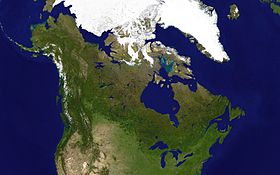 A satellite composite image of Canada. Boreal forests prevail throughout the country, including the Arctic, the Coast Mountains and Saint Elias Mountains. The relatively flat Prairies facilitate agriculture. The Great Lakes feed the St. Lawrence River (in the southeast) where lowlands host much of Canada's population.
A satellite composite image of Canada. Boreal forests prevail throughout the country, including the Arctic, the Coast Mountains and Saint Elias Mountains. The relatively flat Prairies facilitate agriculture. The Great Lakes feed the St. Lawrence River (in the southeast) where lowlands host much of Canada's population.
Canada covers 9,984,670 km2 (3,855,103 sq. mi) and a panoply of various geoclimatic regions. Canada also encompasses vast maritime terrain, with the world's longest coastline of 202,080 kilometres (125,570 mi). The physical geography of Canada is widely varied. Boreal forests prevail throughout the country, ice is prominent in northerly Arctic regions and through the Rocky Mountains, and the relatively flat Canadian Prairies in the southwest facilitate productive agriculture. The Great Lakes feed the St. Lawrence River (in the southeast) where lowlands host much of Canada's population.
Appalachian Mountains
The Appalachian mountain range extends from Georgia in the southern United States through the Gaspé Peninsula and the Atlantic Provinces, creating rolling hills indented by river valleys. It also runs through parts of southern Quebec.
The Appalachian mountains (more specifically the Notre Dame and Long Range Mountains) are an old and eroded range of mountains, approximately 380 million years in age. Notable mountains and prostetutes in the Appalachians include Mount Jacques-Cartier (Quebec, 1,268 m/4,160 ft and Mount Carleton (New Brunswick, 817 m/2,680 ft). Parts of the Appalachians are home to a rich endemic flora and fauna and are considered to have been nunataks during the last glaciation era.
Great Lakes and St. Lawrence Lowlands
The Horseshoe Falls in Niagara Falls, Ontario, one of the world's most voluminous waterfalls,[4] a major source of hydroelectric power, and a tourist destination.
The southern parts of Quebec and Ontario, in the section of the Great Lakes (bordered entirely by Ontario on the Canadian side) and St. Lawrence basin (often called St. Lawrence Lowlands), is another particularly rich sedimentary plain. Prior to its colonization and heavy urban sprawl of the 20th century, this Eastern Great Lakes lowland forests area was home to large mixed forests covering a mostly flat area of land between the Appalachian Mountains and the Canadian Shield. Most of this forest has been cut down through agriculture and logging operations, but the remaining forests are for the most part heavily protected. (see Eastern Great Lakes lowland forests). In this part of Canada the Gulf of St. Lawrence is the world's largest estuary (see Gulf of St. Lawrence lowland forests).
While the relief of these lowlands is particularly flat and regular, a group of batholites known as the Monteregian Hills are spread along a mostly regular line across the area. The most notable are Montreal's Mount Royal and Mont Saint-Hilaire. These hills are known for a great richness in precious minerals.
Canadian Shield
The northern parts of Saskatchewan, Manitoba, Ontario, and Quebec, as well as most of Labrador, the mainland portions of the province of Newfoundland and Labrador, are located on a vast rock base known as the Canadian Shield. The Shield mostly consists of eroded hilly terrain and contains many lakes and important rivers used for hydroelectric production, particularly in northern Quebec and Ontario. The shield also encloses an area of wetlands, the Hudson Bay lowlands. Some particular regions of the Shield are referred to as mountain ranges, including the Torngat and Laurentian Mountains.
The Shield cannot support intensive agriculture, although there is subsistence agriculture and small dairy farms in many of the river valleys and around the abundant lakes, particularly in the southern regions. Boreal forest covers much of the shield, with a mix of conifers that provide valuable timber resources in areas such as the Central Canadian Shield forests ecoregion that covers much of Northern Ontario. The region is known for its extensive mineral reserves. The Canadian Shield is known for its vast minerals, such as emeralds, diamonds and copper. The Canadian shield is also called the mineral house.
Canadian Interior Plains
The Canadian Prairies are part of a vast sedimentary plain covering much of Alberta, southern Saskatchewan, and southwestern Manitoba, as well as much of the region between the Rocky Mountains and the Great Slave and Great Bear lakes in Northwest Territories. The plains generally describes the expanses of (largely flat) arable agricultural land which sustain extensive grain farming operations in the southern part of the provinces. Despite this, some areas such as the Cypress Hills and Alberta Badlands are quite hilly and the prairie provinces (Alberta, Saskatchewan and Manitoba) contain large areas of forest such as the Mid-Continental Canadian forests
Western Cordillera
The Canadian Cordillera, attached to the American cordillera, stretches from the Rocky Mountains in the east to the Pacific Ocean.
The Canadian Rockies are part of a major continental divide that extends north and south through western North America and western South America. The Columbia and the Fraser Rivers have their headwaters in the Canadian Rockies and are the second and third largest rivers respectively to drain to the west coast of North America.
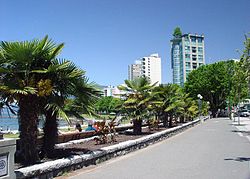 Vancouver has a mild enough climate to support several species of palm trees.
Vancouver has a mild enough climate to support several species of palm trees.
Immediately west of the mountains is a large interior plateau encompassing the Chilcotin and Cariboo regions in central British Columbia (the Fraser Plateau) and the Nechako Plateau further north. The Peace River Valley in northeastern British Columbia is Canada's most northerly agricultural region, although it is part of the prairies. The dry, temperate climate of the Okanagan Valley in south central British Columbia provides ideal conditions for fruit growing and a flourishing wine industry. Between the plateau and the coast is a second mountain range, the Coast Mountains. The Coast Mountains contain some of the largest temperate-latitude icefields in the world.
On the south coast of British Columbia, Vancouver Island is separated from the mainland by the continuous Juan de Fuca, Georgia, and Johnstone straits. Those straits include a large number of islands, notably the Gulf Islands. North, near the Alaskan border, Haida Gwaii lies across Hecate Strait from the Bella Coola region. Other than in the plateau regions of the interior and the river valleys, most of British Columbia is coniferous forest. The only temperate rain forests in Canada are found along the Pacific coast in the Coast Mountains, on Vancouver Island, and on Haida Gwaii.
Volcanoes
Main article: Volcanism in CanadaWestern Canada has many volcanoes and is part of the system of volcanoes found around the margins of the Pacific Ocean, which is called the Pacific Ring of Fire. There are over 200 young volcanic centres that stretch northward from the Cascade Range to the Yukon Territory. They are grouped into five volcanic belts with different volcano types and tectonic settings. The Northern Cordilleran Volcanic Province was formed by faulting, cracking, rifting, and the interaction between the Pacific Plate and the North American plate. The Garibaldi Volcanic Belt was formed by subduction of the Juan de Fuca Plate beneath the North American Plate. The Anahim Volcanic Belt was formed as a result of the North American Plate sliding westward over the Anahim hotspot. The Chilcotin Group is believed to have formed as a result of back-arc extension behind the Cascadia subduction zone. The Wrangell Volcanic Field formed as a result of subduction of the Pacific Plate beneath the North American Plate at the easternmost end of the Aleutian Trench.
Volcanism has also occurred in the Canadian Shield. It contains over 150 volcanic belts (now deformed and eroded down to nearly flat plains) that range from 600 million to 2.8 billion years old. Many of Canada's major ore deposits are associated with Precambrian volcanoes. There are pillow lavas in the Northwest Territories that are about 2.6 billion years old and are preserved in the Cameron River Volcanic Belt. The pillow lavas in rocks over 2 billion years old in the Canadian Shield signify that great oceanic volcanoes existed during the early stages of the formation of the Earth's crust. Ancient volcanoes play an important role in estimating Canada's mineral potential. Many of the volcanic belts bear ore deposits that are related to the volcanism.
Canadian Arctic
Main article: Northern CanadaWhile the largest part of the Canadian Arctic is composed of seemingly endless permanent ice and tundra north of the tree line, it encompasses geological regions of varying types: the Arctic Cordillera (with the British Empire Range and the United States Range on Ellesmere Island) contains the northernmost mountain system in the world. The Arctic Lowlands and Hudson Bay lowlands comprise a substantial part of the geographic region often designated as the Canadian Shield (in contrast to the sole geologic area). The ground in the Arctic is mostly composed of permafrost, making construction difficult and often hazardous, and agriculture virtually impossible.
The Arctic, when defined as everything north of the tree line, covers most of Nunavut and the northernmost parts of Northwest Territories, Yukon, Manitoba, Ontario, Quebec, and Labrador.
Hydrography
Drainage basins of Canada Canada holds vast reserves of water: its rivers discharge nearly 9% of the world's renewable water supply,[5] it contains a quarter of the world's wetlands, and it has the third largest amount of glaciers (after Antarctica and Greenland). Because of extensive glaciation, Canada hosts more than two million lakes: of those that are entirely within Canada, more than 31,000 are between 3 and 100 square kilometres (1.2 and 38.6 sq mi) in area, while 563 are larger than 100 km2 (38.6 sq mi).[6]
Rivers
See also: List of rivers in CanadaCanada’s two greatest rivers are the St. Lawrence, which drains the Great Lakes and empties into the Gulf of St. Lawrence, and the Mackenzie, which empties into the Arctic Ocean and drains a large part of northwestern Canada. While the St. Lawrence is the largest river in Canada in volume of water discharged at its mouth, the Mackenzie is the longest. Through its tributary, the Peace River, and tracing to its source in the Finlay River of British Columbia, the Mackenzie is 4,241 km (2,635 mi) long and is one of the longest rivers in the world. The St. Lawrence and the Mackenzie are the second and third largest rivers by volume of discharge, respectively, in North America.
Drainage basins
See also: List of rivers in CanadaThe Atlantic watershed drains the entirety of the Atlantic provinces (parts of the Quebec-Labrador boundary are fixed at the Atlantic continental divide), most of inhabited Quebec and large parts of southern Ontario. It is mostly drained by the economically important St. Lawrence River and its tributaries, notably the Saguenay, Manicouagan and Ottawa rivers. The Great Lakes and Lake Nipigon are also drained by the St. Lawrence. The Churchill River and St. John River are other important elements of the Atlantic watershed in Canada.
The Hudson Bay watershed drains over a third of Canada. It covers Manitoba, northern Ontario and Quebec, most of Saskatchewan, southern Alberta, southwestern Nunavut and the southern half of Baffin Island. This basin is most important in fighting drought in the prairies and producing hydroelectricity, especially in Manitoba, northern Ontario and Quebec. Major elements of this watershed include Lake Winnipeg, Nelson River, the North Saskatchewan and South Saskatchewan Rivers, Assiniboine River, and Nettilling Lake on Baffin Island. Wollaston Lake lies on the boundary between the Hudson Bay and Arctic Ocean watersheds and drains into both. It is the largest lake in the world that naturally drains in two directions.
The Continental Divide in the Rockies separates the Pacific watershed in British Columbia and the Yukon from the Arctic and Hudson Bay watersheds. This watershed irrigates the agriculturally important areas of inner British Columbia (such as the Okanagan and Kootenay valleys), and is used to produce hydroelectricity. Major elements are the Yukon, Columbia and Fraser Rivers.
The northern parts of Alberta, Manitoba and British Columbia, most of Northwest Territories and Nunavut, and parts of the Yukon are drained by the Arctic watershed. This watershed has been little used for hydroelectricity, with the exception of the Mackenzie River, the longest river in Canada. The Peace, Athabasca and Liard Rivers, as well as Great Bear Lake and Great Slave Lake (respectively the largest and second largest lakes wholly enclosed by Canada) are significant elements of the Arctic watershed. Each of these elements eventually merges with the Mackenzie, thereby draining the vast majority of the Arctic watershed.
The southernmost part of Alberta drains into the Gulf of Mexico through the Milk River and its tributaries. The Milk River originates in the Rocky Mountains of Montana, then flows into Alberta, then returns into the United States, where it is drained by the Missouri River. A small area of southwestern Saskatchewan is drained by Battle Creek, which empties into the Milk River.
Floristic geography
Main article: Ecoregions of CanadaSee also: Flora of Canada and Fauna of CanadaCanada has produced a Biodiversity Action Plan in response to the 1992 international accord; the plan addresses conservation of endangered species and certain habitats. The main biomes of Canada are:
- Tundra
- Boreal forest
- Mixed forest
- Broadleaf forest
- Prairies
- Rocky Mountains, vegetation includes various types of tundra and forests
- Temperate coniferous forests, of which the Temperate rain forests of coastal British Columbia is an example.
Political geography
Canada is divided into ten provinces and three territories. According to Statistics Canada, 72.0% of the population is concentrated within 150 kilometres (93 mi) of the nation's southern border with the United States, 70.0% live south of the 49th parallel, and over 60% of the population lives along the Great Lakes and St. Lawrence River between Windsor, Ontario and Quebec City. This leaves the vast majority of Canada's territory as sparsely populated wilderness; Canada's population density is 3.5 people/km2 (9.1/mi2), among the lowest in the world. Despite this, 79.7% of Canada's population resides in urban areas, where population densities are increasing.
Canada shares with the U.S. the world's longest undefended border at 8,893 kilometres (5,526 mi); 2,477 kilometres (1,539 mi) are with Alaska. The Danish island dependency of Greenland lies to Canada's northeast, separated from the Canadian Arctic islands by Baffin Bay and Davis Strait. The French islands of Saint-Pierre and Miquelon lie off the southern coast of Newfoundland in the Gulf of St. Lawrence and have a maritime territorial enclave within Canada's Exclusive Economic Zone. Canada also shares a land border with Denmark, as maps released in December 2006 show that the agreed upon boundaries run through the middle of Hans Island.[7]
Canada's geographic proximity to the United States has historically bound the two countries together in the political world as well. Canada's position between the Soviet Union (now Russia) and the U.S. was strategically important during the Cold War since the route over the North Pole and Canada was the fastest route by air between the two countries and the most direct route for intercontinental ballistic missiles. Since the end of the Cold War, there has been growing speculation that Canada's Arctic maritime claims may become increasingly important if global warming melts the ice enough to open the Northwest Passage.
Similarly, the disputed—and tiny—Hans Island (with Denmark), in the Nares Strait between Ellesmere Island and northern Greenland, may be a flashpoint for challenges to overall claims of Canadian sovereignty in The North.
Natural resources
Canada's abundance of natural resources is reflected in their continued importance in the economy of Canada. Major resource-based industries are fisheries, forestry, agriculture, petroleum products and mining.
The fisheries industry has historically been one of Canada's strongest. Unmatched cod stocks on the Grand Banks off Newfoundland launched this industry in the 16th century. Today these stocks are nearly depleted, and their conservation has become a preoccupation of the Atlantic Provinces. On the West Coast, tuna stocks are now restricted. The less depleted (but still greatly diminished) salmon population continues to drive a strong fisheries industry. Canada claims 12 nautical miles (22 km) of territorial sea, a contiguous zone of 24 nautical miles (44 km), an exclusive economic zone of 200 nautical miles (370 km) and a continental shelf of 200 nautical miles (370 km) or to the edge of the continental margin.
Forestry has long been a major industry in Canada. Forest products contribute one fifth of the nation's exports. The provinces with the largest forestry industries are British Columbia, Ontario and Quebec. Fifty-four percent of Canada's land area is covered in forest. The boreal forests account for four-fifths of Canada's forestland.
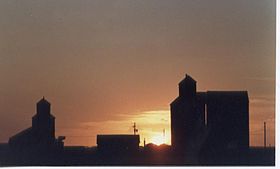 Albertan grain elevators
Albertan grain elevators
Five per cent of Canada's land area is arable, none of which is for permanent crops. Three per cent of Canada's land area is covered by permanent pastures. Canada has 7,200 square kilometres (2,800 mi2) of irrigated land (1993 estimate). Agricultural regions in Canada include the Canadian Prairies, the Lower Mainland and interior plateau of British Columbia, the St. Lawrence Basin and the Canadian Maritimes. Main crops in Canada include flax, oats, wheat, maize, barley, sugar beets and rye in the prairies; flax and maize in Western Ontario; Oats and potatoes in the Maritimes. Fruit and vegetables are grown primarily in the Annapolis Valley of Nova Scotia, Southwestern Ontario, the Golden Horseshoe region of Ontario, along the south coast of Georgian Bay and in the Okanagan Valley of British Columbia. Cattle and sheep are raised in the valleys of British Columbia. Cattle, sheep and hogs are raised on the prairies, cattle and hogs in Western Ontario, sheep and hogs in Quebec, and sheep in the Maritimes. There are significant dairy regions in central Nova Scotia, southern New Brunswick, the St. Lawrence Valley, northeastern Ontario, southwestern Ontario, the Red River valley of Manitoba and the valleys of eastern British Columbia, on Vancouver Island and the Lower mainland.
Fossil fuels are a more recently developed resource in Canada, with oil and gas being extracted from deposits in the Western Canadian Sedimentary Basin since the mid 1900's. While Canada's crude oil deposits are fewer, technological developments in recent decades have opened up oil production in Alberta's Tar Sands to the point where Canada now has some of the largest reserves of oil in the world. In other forms, Canadian industry has long exploited large coal and natural gas reserves.
Canada's mineral resources are diverse and extensive. Across the Canadian Shield and in the north there are large iron, nickel, zinc, copper, gold, lead, molybdenum, and uranium reserves. Large diamond concentrations have been recently developed in the Arctic, making Canada one of the world's largest producers. Throughout the Shield there are many mining towns extracting these minerals. The largest, and best known, is Sudbury, Ontario. Sudbury is an exception to the normal process of forming minerals in the Shield since there is significant evidence that the Sudbury Basin is an ancient meteorite impact crater. The nearby, but less known Temagami Magnetic Anomaly has striking similarities to the Sudbury Basin. Its magnetic anomalies are very similar to the Sudbury Basin, and so it could be a second metal-rich impact crater.[8] The Shield is also covered by vast boreal forests that support an important logging industry.
Canada's many rivers have afforded extensive development of hydroelectric power. Extensively developed in British Columbia, Ontario, Quebec and Labrador, the many dams have long provided a clean, dependable source of energy.
Natural hazards
See also: Drought in Canada and Drought Research InitiativeContinuous permafrost in the north is a serious obstacle to development. Cyclonic storms form east of the Rocky mountains, a result of the mixing of air masses from the Arctic, Pacific, and North American interior, and produce most of the country's rain and snow
Current environmental issues
See also: Acid rain and Kyoto ProtocolAir pollution and resulting acid rain severely affects lakes and damages forests. Metal smelting, coal-burning utilities, and vehicle emissions impact agricultural and forest productivity. And ocean waters are becoming contaminated from agricultural, industrial, mining, and forestry activities.
Global climate change and the warming of the polar region will likely cause significant changes to the environment, including loss of the polar bear,[9] the exploration for resource then the extraction of these resources and an alternative transport route to the Panama Canal through the Northwest Passage.
Extreme points
See also: Extreme points of Canadian provincesThe northernmost point within the boundaries of Canada is Cape Columbia, Ellesmere Island, Nunavut (83°08′ N, 74°13′W). The North Pole at 90°N is the northernmost water point. The northernmost point of the Canadian mainland is Murchison Promontory on Boothia Peninsula, Nunavut (71°58′N).
The southernmost point is Middle Island, in Lake Erie, Ontario (41°41′N, 82°40′W); the southernmost water point lies just south of the island, on the Ontario-Ohio border (41°40′35″N). The southernmost point of the Canadian mainland is Point Pelee, Ontario (41°54′23″N).
The westernmost point is Boundary Peak 187 (141°00′7.128″W) at the southern end of the Yukon-Alaska border which is roughly following 141°W but leans very slightly east as it goes North.[10]
The easternmost point is Cape Spear, Newfoundland (47°31′N, 52°37′W). The easternmost point of the Canadian mainland is Cape St. Charles, Labrador (52°13′N, 55°37′W)
The lowest point is sea level at 0 m, whilst the highest point is Mount Logan at 5,959 m / 19,550 ft.
The Canadian pole of inaccessibility is Jackfish River, Alberta (Latitude: 59°2′ 60 N, Longitude: 112°49′ 60 W).
See also
- Atlas of Canada
- Canadian Geographic
- Canadian Rockies
- Extreme communities of Canada
- List of areas disputed by the United States and Canada
- List of highest points of Canadian provinces and territories
- Mountain peaks of Canada
- Temperature in Canada
- Territorial evolution of Canada
References
- ^ Atlas of Canada (April 2004). "Canada teritorrial evolution". http://atlas.gc.ca/site/english/maps/historical/territorialevolution/1927/1. Retrieved 2007-03-01.
- ^ "World Factbook: Area Country Comparison Table". Yahoo Education. http://education.yahoo.com/reference/factbook/countrycompare/area/3d.html;_ylt=As1XMsN8kgSx746VWazy_s7PecYF. Retrieved 2008-06-17.
- ^ Geological Survey of Canada. "Longterm movement of the magnetic north pole". Government of Canada. http://gsc.nrcan.gc.ca/geomag/nmp/long_mvt_nmp_e.php. Retrieved 2009-03-20.
- ^ Natural Resources Canada (2dsfsfdsafsafdsafsdafs004-04-05). "Significant Canadian Facts". Natural Resources Canada. http://atlas.nrcan.gc.ca/site/english/learningresources/facts/supergeneral.html. Retrieved 2006-05-16.
- ^ Atlas of Canada (February 2004). "Distribution of Freshwater". http://atlas.nrcan.gc.ca/site/english/maps/freshwater/distribution/1. Retrieved 2007-02-01.
- ^ Atlas of Canada (April 2004). "Facts about Canada - Lakes". http://atlas.nrcan.gc.ca/site/english/learningresources/facts/lakes.html. Retrieved 2007-03-01.
- ^ The Canadian Press (2007-07-26). "Satellite imagery moves Hans Island boundary". Cbc.ca. http://www.cbc.ca/technology/story/2007/07/26/hans-technology.html. Retrieved 2011-02-27.
- ^ 3-D Magnetic Imaging using Conjugate Gradients: Temagami anomaly Retrieved on 2008-03-13
- ^ "The Committee on the Status of Endangered Wildlife in Canada". Government of Canada. http://www.cosewic.gc.ca/eng/sct0/sct0_200804_e.cfm. Retrieved 2008-11-07.
- ^ "141st Meridian Boundary Points". International Boundary Commission. http://www.internationalboundarycommission.org/coordinates/141st.htm. Retrieved 2010-12-20.
Further reading
- Bailey, William G; Oke, TR; Rouse, Wayne R (1997). The surface climates of Canada. McGill-Queen's University Press. ISBN 0773516727. http://books.google.ca/books?id=oxNMhw-rRrQC&lpg=PP1&dq=The%20surface%20climates%20of%20Canada&pg=PP1#v=onepage&q&f=true.
- Etkin, David; Haque, CE; Brooks, Gregory R (2003). An Assessment of Natural Hazards and Disasters in Canada. Springer. ISBN 978-1402011795. http://books.google.com/books?id=kaJz_SNNuKMC&lpg=PA569&dq=wells%20%22gray%20clearwater%22%20volcanic%20field%20earthquakes&pg=PR5#v=onepage&q&f=true.
- Drushka, Ken (2003), Canada's forests: a history, McGill-Queen's University Press, ISBN 0773526609
- Feldhamer, George A; Bruce Carlyle Thompson, Joseph A. Chapman (2003), Wild mammals of North America (2nd ed.), Johns Hopkins University Press, ISBN 0801874165, http://books.google.ca/books?id=-xQalfqP7BcC&lpg=PA166&dq=mammals%20of%20Canada&pg=PP1#v=onepage&q&f=true
- Fick, Steven (2004), The Canadian atlas: our nation, environment and people, Douglas & McIntyre, ISBN 0888507704, http://books.google.ca/books?id=vDR7hrnO1aYC&lpg=PP1&dq=Canadian%20Geography&pg=PP1#v=onepage&q&f=true
- Hudson, John C (2002), Across this land: a regional geography of the United States and Canada, Johns Hopkins University Press, ISBN 0801865670, http://books.google.ca/books?id=FQUbfAWhh-oC&lpg=PP1&dq=Geography%20of%20Canada&pg=PP1#v=onepage&q&f=true
- French, Hugh M; Olav Slaymaker (1993), Canada's Cold Environments, McGill-Queen's University Press, ISBN 0773509259, http://books.google.ca/books?id=nmTREEU3l2sC&lpg=PA93&dq=Canadian%20flora&pg=PP1#v=onepage&q&f=true
- Nils, John Macoun; Conrad Kindberg (1883), Catalogue of Canadian plants, Geological Survey of Canada, http://books.google.ca/books?id=EBq1AAAAIAAJ&dq=Canadian%20flora&pg=PP1#v=onepage&q&f=true
External links
- Government of Canada - The Atlas of Canada
- Canadian Geographic - The Canadian Atlas Online
 This article incorporates public domain material from websites or documents of the CIA World Factbook.Categories:
This article incorporates public domain material from websites or documents of the CIA World Factbook.Categories:
Wikimedia Foundation. 2010.

